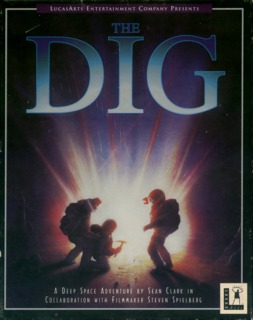What do George Lucas, Steven Spielberg, Orson Scott Card, Robert Patrick, and Brian Moriarty have in common? The Dig, of course. Released in 1995 by LucasArts, The Dig pools the varied talents of this all-star team to create a sci-fi adventure game that shows great promise yet sadly does not live up to expectations.
Development on The Dig began in 1989 amidst speculation and excitement. Indeed, the game's production history was perhaps more of an adventure than the finished product itself. Supposedly, Steven Spielberg approached LucasArts with the idea for a new sci-fi video game. The germ of this idea went through many different development teams and game engines, reaching a nearly finished form under the direction of Brian Moriarty, who was previously the lead designer of Loom. The final developer, Sean Clark, whittled the story down into a more palatable, concise form and had the dialog rewritten by novelist Orson Scott Card before finally getting the game released 6 years later.
The Dig begins with a desperate NASA mission for the space shuttle to divert an asteroid named Attila (after the famous Hun invader) which is on a direct collision course with Earth. You play Boston Low (voiced by Robert Patrick of Terminator 2: Judgment Day fame), a no-nonsense NASA commander determined to avert the threat to Earth who is accompanied by geologist Ludger Brink and reporter turned astronaut Maggie Robbins. Yet, all is not as it seems on Attila, when the asteroid turns out to be a spaceship that transports the crew to the long dead world of Cocytus. There, they must try to work together in the struggle to survive and decrypt the series of messages left to them by the world's disappeared inhabitants in order to find their way back home.
Although the storyline is reasonably well constructed and interesting, the concept is trite. Science fiction is already riddled with too many alien first contact stories, and the story in this game does little to stand out. The cheesy dialog makes it worse. Not only is it brief and sometimes uninformative, it is entirely devoid of all but the most forced humor. It is a wonder how Orson Scott Card did such a poor job, or alternatively, how much he really had to do with the final version of the script. The poor dialog may have been redeemable if at least it demonstrates LucasArts' trademark humor, but it does not, and the game is left with a script that is neither funny nor intelligent. The voice acting is of substantially higher quality, but it cannot make up for the limitations of the script.
The poor scripting detracts from the reality of the setting and mood that the game attempts to create. Unlike the exotic locales commonly seen in other adventure games, the world of Cocytus lacks texture and depth. There is a dearth of textual and verbal description, making the story and world less compelling than the hand drawn graphics suggest. Indeed, the background visuals are quite creative, albeit a few years outdated even for 1995 due to the game's interminably long development. The character visuals are substantially worse than that, and the cut scenes are cartoon like and outdated as well.
The brightest spot in the arts department is the excellent soundtrack by Michael Land, which in Wagnerian style captures the mysterious, tension filled mood of the game very well.
Gameplay is made simple and intuitive with a single cursor acting as the only interface with the game. It turns blue when it encounters a hotspot, allowing you to interact with people, items, or walk to new locations. There is a fair amount of walking to do, but for impatient gamers (like me), animation sequences of character movement can be bypassed by a simple double-click.
A nice touch is that although you only control Boston Low, Ludger Brink and Maggie Robbins accompany you for some parts of the game. I have never understood why so few adventure games have NPCs (Non-Player Characters) who follow the player. A game is so much more interesting when regular characters accompany the player and give varying perspectives on the situations encountered. I cannot say that The Dig always makes use of the NPCs to the fullest extent, but character interaction gives a strong measure of vitality to a game that may have otherwise been shelved as another Myst clone.
The game's puzzles lack inspiration. They are not interesting to solve, nor do they use much deductive reasoning. Most of the puzzles are inventory based, while some of them require you to talk to your crew or work with them. The difficulty level of the puzzles is somewhat uneven. Many of them are easy, perhaps too easy, while there are a couple that are both difficult and extremely frustrating. On the bright side, there is almost no pixel hunting. Another problem is that too frequently the reward for a difficult solution is simply a "treasure room". Often, puzzles involve opening doors, and through that door is a room which contains a metal plate or an engraved rod which will help you get through another door later in the game. This lack of variation is ably explained by the plot itself—the aliens are testing your ingenuity—but it still makes the game rather tedious and the puzzle solving less integrated with the story.
The Dig is a well thought out sci-fi adventure game with an interesting story and strong characters. Yet, it falls short of the mark with its poor dialog, lack of immersive elements, and less than compelling puzzles. Given LucasArts' impressive history as a game developer, as well as with all the years that went into producing The Dig and all the talented names attached to this project, I wish that the game could have been so much more.

